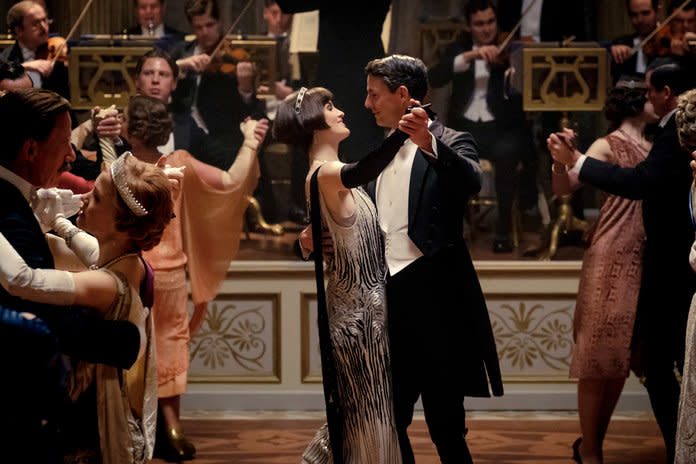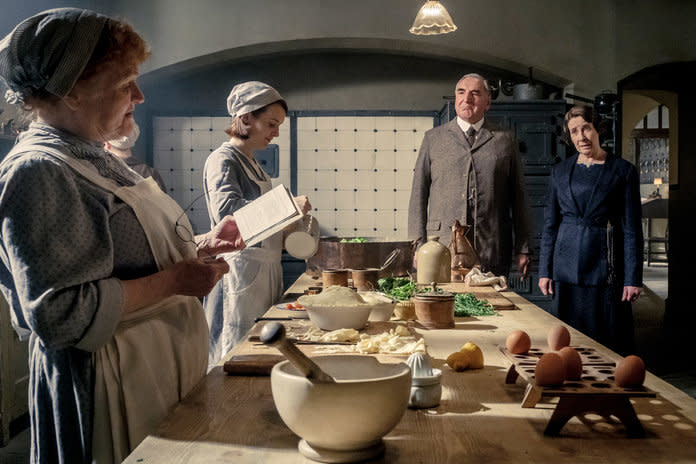It Took Weeks Just to Make a Single Collar For the Downton Abbey Movie
When it comes to movies and TV shows, we’re always curious to find out more about the costumes. Why was Julia Roberts wearing flip-flops in Notting Hill? Where were those teens from Euphoria actually buying their clothing? These are the things that keep us up at night, and after watching the Downton Abbey movie (in theaters now), we couldn’t stop thinking about all the intricate beading and the price tag of some of those jewels.
InStyle decided to speak to costume designer Anna Robbins, AKA the woman behind all those elaborate 1920s outfits, both from the film and the TV show. “I can talk about my costumes for days and days,” she admits. “It's been amazing taking it from small screen to big screen — the scale and grandeur.”
RELATED: Michelle Dockery Talks Returning to Downton Abbey and the "Mary Effect”
Grandeur is definitely the right word. Ahead, Robbins tells us about the process of putting together each and every look, including revamping vintage pieces and spending weeks creating a certain collar.

Jaap Buitendijk/© 2019 Focus Features, LLC
Not only did you design original costumes for the movie, you also used vintage pieces. Can you tell us about that process?
My approach for Downton has always been to source vintage where I can, where the quality and the condition of the pieces are good enough to stand up on screen. For womenswear, and specifically eveningwear, you can find some really beautiful original 1920s garments out there. For certain characters, I would tend to make [the costumes] from scratch, possibly using vintage materials, and then, for others, use originals. It depends on what you can find.
Lady Edith tends to wear a lot of original because the color palette, the detailing, and the style of those pieces are out there, whereas for Lady Mary I would design from scratch a bit more, because I had such specific ideas about how I wanted her to look and couldn't find original garments to sort of fit into that. It's about 50/50 in terms of vintage and new makes. With the gentlemen, it's much more bespoke tailoring, because the originals don't exist, and if they do exist, they're not the right size or proportion for our modern gentlemen.
What costume took the longest to make or put together?
As a general rule, Violet's costumes take longer than the other women because of the complexity of their construction. It's more Edwardian in its cut and its makeup. The same can be said about Queen Mary. There were very complicated undergarments for Queen Mary's costume, because we had to create a completely different silhouette for Geraldine James [who plays her in the film] than her natural body shape. We spent a long of time getting the foundation right. When you have the right foundation, the costume looks correct sitting on top of that. Her costumes took a long time, and there’s a huge amount of detail in them. There was amazing smocking of the wool on the collar of her coat, which took weeks.
With Violet, there's embroidery and detailing on her coat and dress for the parade. And her ballgown. These are all costumes that took weeks and weeks to put together. Lady Mary's ballgown for the Royal Ball was a real labor of love. We had to hand-bead the bottom half of her dress to lengthen it down to the ground. It was an original dress that was knee-length to being with, and we had to graft a satin train to it and then that was hand-beaded. It felt like it had always been that way. There's a huge amount of work that goes into every costume to be honest, and every single original piece that we buy goes to the work women and has restoration done on it — it might need to be strengthened. There are very talented people that work for long hours to get the costumes ready for me.

What was the most expensive costume to make?
It's difficult to quantify. Original 1920s isn't cheap by any stretch, because of the craftsmanship, but then it goes to the process of the work women, and the amount of time that's been spent on the costume makes it more and more valuable. But the most expensive pieces in the film are absolutely, unquestionably, the tiaras that Violet, Edith, and Cora wear at the ball. They are diamond tiaras that we were loaned by Bentley & Skinner. They are worth many, many thousands of pounds.
What are some details we should pay attention to while we watch the film?
The shoes are all designed and made, and you kind of always hope you're going to get a shoe shot. Actually, it’s really wonderful in the film — we get a great shot of Lady Mary's two-tone navy and cream shoes at certain point. Her foot gets a great closeup. There's detailing everywhere, and that's the beauty of it. It's so rich, and embellished, and sumptuous. I can probably watch the film myself five times and concentrate on hats, bags, gloves, dresses, and shoes on each viewing.

Liam Daniel/© 2019 Focus Features, LLC
Were there any color choices you used to portray certain moods?
With every scene that is scripted, I'll think about composing the colors, so that there's a beautiful composition to the scene. But I’m also looking to accent whoever is at the center of that scene. You start with that and the color that works for the tone, and then you work out the rest of the cast in relation to that person. There are a lot of ways I've done that within this film. Specifically, I've looked at a sort of journey of color and tone for Violet with her storyline — starting off with such a rich navy and gold, and moving through mauves and smokier colors, then ending up with this really beautiful, pale blue-green ballgown which has a lightweight chiffon and embroidered tulles. There's a real delicacy to that costume, and that's [connected to] such an emotional journey.
Quite often, I look at creating a contrast between Mary and Edith. There's often something contrasting between them, conflicting perhaps. Seeing them as the individuals that they are, so they're always very distinct, and yet, they work well together. In every scene there is a thought process about what colors will work and how they'll play off against each other.
Are there any callbacks to costumes from the show that people will recognize in the film?
If you're a super-fan, perhaps. It was important to me that it didn't feel like it was a completely standalone feature that wasn't related to the series in any way, so we've repeated elements of wardrobes across all of the characters. It might be a coat, or a skirt, or pair of shoes, or a hat. They have some of the same bags and definitely some of the same jewelry — the heirloom jewelry — because they're working wardrobes. They're wardrobes that evolve; they don't just suddenly change. Obviously I didn't repeat anything that was really significant or iconic from the series, and if there were any important scenes within the film, then the costumes were all new. But there is definitely an overlap. Mrs. Patmore is still wearing the coat she wore on the first day of the first series because it's her coat, she will not be without it. And we did offer to make her a new one and Lesley [Nicol, who plays the character] said, "No, no, this is my coat.” There are favorites that are still present and that tells as much of a story as the new costumes do.


